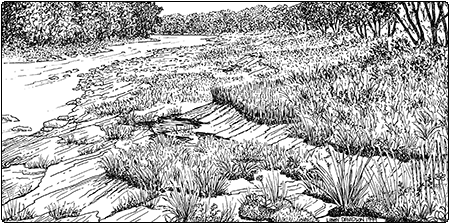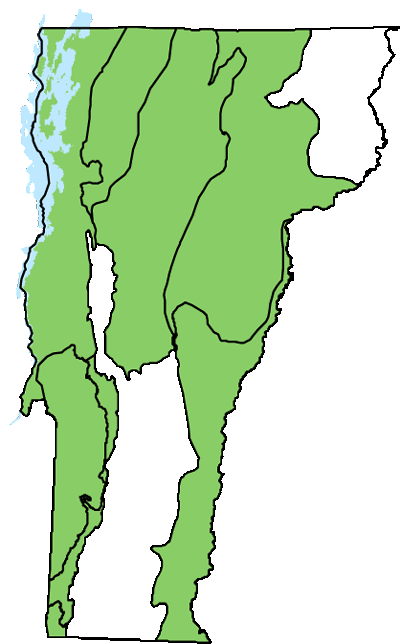Ecology and Physical Setting 
Calcareous Riverside Seeps are botanical treasures. This very rare community occurs along the shorelines of several of Vermont’s larger rivers in areas of calcareous bedrock. Like many other shoreline communities, Calcareous Riverside Seeps are maintained in an open condition by periodic flooding and ice-scouring. What gives this community its distinct character, however, is the presence of calcium-rich groundwater that seeps out of the river bank and flows over scoured bedrock. This groundwater is enriched with dissolved minerals as it flows through gaps in the bedrock and associated glacial till.
In addition to exposed bedrock, there may be pockets of silt, sand, gravel, or cobble. The finest textured alluvial deposits accumulate in the bedrock fissures and in the gaps between cobbles and large gravel. The calcium-rich water seeping through these crevices provides an ideal habitat for many grasses, sedges, herbs, and bryophytes. Annual decomposition of this vegetation adds organic matter to the fine-textured alluvium. Flooding and scouring keep these peaty accumulations small and shallow.
Calcareous Riverside Seeps are commonly associated with other river shore communities, especially Riverside Outcrops.
Vegetation

with Calcareous Riverside Seep community.
While Calcareous Riverside Seeps superficially resemble Riverside Outcrops, their vegetation has more in common with Rich Fens. In areas with less seepage and more exposed bedrock, vegetation can be sparse and conditions may be relatively dry. In contrast, in areas with consistent groundwater seepage and some shelter from annual scouring, vegetation is dense.
Characteristic herbs include grass of Parnassus, capitate beak-rush, pumpkin sedge, Kalm’s lobelia, and Loesel’s twayblade. Variegated scouring-rush and yellow sedge can be dominant. Scattered shrubs of woolly-headed willow, shrubby cinquefoil, and alder may be present.
Several rare or uncommon plants are also closely associated with this community. Among these rarities are Garber’s sedge, sticky false asphodel, fringed gentian, and shining ladies’ tresses.
Often there is a well-developed moss component, and many species characteristic of fens are found in Calcareous Riverside Seeps as well. Typical species include starry campylium, Ptychostomum pseudotriquetrum, Philonotis fontana, and Drepanocladus species.
Wildlife Habitat
River otters and mink include these wet outcrops on their patrol of the river shorelines. Belted kingfishers and great blue herons may perch on these outcrops while observing and fishing the river. The mix of open water, rock, wet organic soils, and unusual flowering plants provides habitat for dragonflies, bees, and other invertebrates, but these have not been studied. An andrena bee, Andrena parnassiae, specializes on grass-of-parnassus—a plant that is common in these seeps.
Related Communities
- Rich Fen is also associated with calcareous groundwater seepage and shares some species with Calcareous Riverside Seep, but it occurs on peat away from rivers. Sedges and mosses dominate.
- Riverside Outcrop occurs in areas where there is no groundwater discharge. The exposed bedrock of this community is scoured by the river but is otherwise dry. Grasses and low herbs dominate the sparse vegetation.
Conservation Status and Management Considerations
Given the extreme rarity of this community, all examples in Vermont should be protected, either by public ownership or through conservation easements with interested landowners. Regardless of conservation status, these all need careful stewardship.
Potential threats to this community include agricultural runoff, spread of non-native invasive plants, and alteration of river flows through operation of dams. As with other wetland types that are closely associated with calcareous groundwater seepage, long-term conservation of Calcareous Riverside Seeps will require protection of their groundwater sources.
Distribution/Abundance 
This very rare Vermont community is found only on rivers flowing over calcareous bedrock. It is rare throughout its range, with scattered locations in areas of calcareous bedrock in New York, Connecticut, Maine, New Hampshire, Pennsylvania, and West Virginia.
Characteristic Plants
Shrubs
Occasional to Locally Abundant Species
Woolly-headed willow – Salix eriocephala
Shrubby cinquefoil – Dasiphora fruticosa
Herbs
Abundant Species
Variegated scouring-rush – Equisetum variegatum
Capillary beak-rush – Rhynchospora capillacea
Pumpkin sedge – Carex aurea
Yellow sedge – Carex flava
Porcupine sedge – Carex hystericina
Occasional to Locally Abundant Species
Kalm’s lobelia – Lobelia kalmii
Grass of Parnassus – Parnassia glauca
Loesel’s twayblade – Liparis loeselii
Meadow spike-moss – Selaginella apoda
Garber’s sedge – Carex garberi
Sticky false asphodel – Triantha glutinosa
Northern bugleweed – Lycopus uniflorus
Balsam ragwort – Packera paupercula
Matted spikerush – Eleocharis intermedia
Non-native Invasive Plants
Coltsfoot – Tussilago farfara
Purple loosestrife – Lythrum salicaria
Common reed – Phragmites australis ssp. australis
Bryophytes
Abundant Species
Starry campylium – Campylium stellatum
Moss – Ptychostomum pseudotriquetrum
Occasional to Locally Abundant Species
Moss – Philonotis fontana
Moss – Drepanocladus spp.
Rare and Uncommon Plants
Capillary beak-rush – Rhynchospora capillacea
Garber’s sedge – Carex garberi
Sticky false asphodel – Triantha glutinosa
Fringed gentian – Gentianopsis crinita
Shining ladies’ tresses – Spiranthes lucida
Greenish sedge – Carex viridula
Atlantic sedge – Carex atlantica var. atlantica
Musk flower – Erythranthe moschata
Grass-leaved rush – Juncus marginatus
Few-flowered spikerush – Eleocharis quinqueflora
Associated Animals
River otter – Lontra canadensis
Mink – Neovison vison
Belted kingfisher – Megaceryle alcyon
Great blue heron – Ardea herodias
Spotted sandpiper – Actitis macularius
Andrena bee – Andrena parnassiae
Places to Visit
White River Wildlife Management Area, Sharon, Vermont Fish and Wildlife Department
